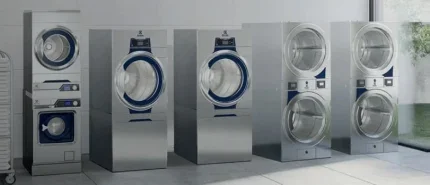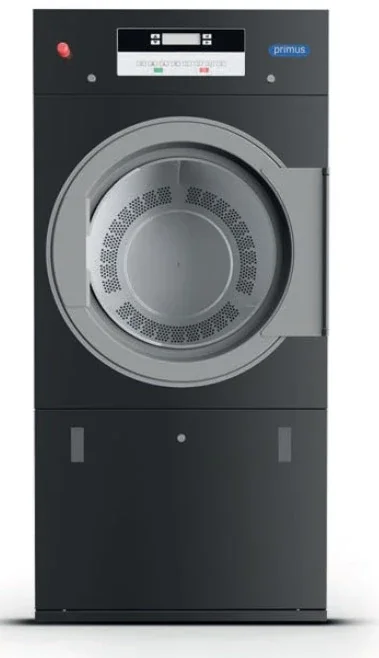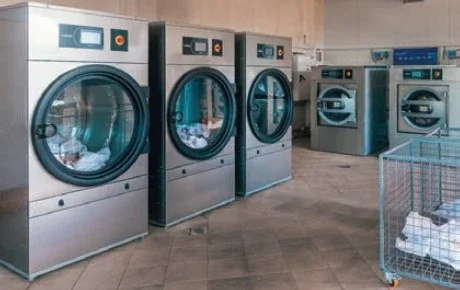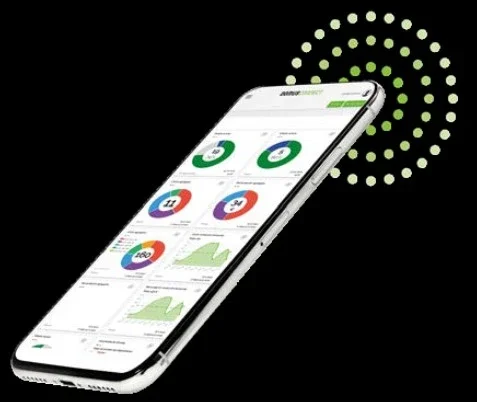
Electrolux says efficient drying starts with the washer-extractor. As Mike Christian, training and development manager for Electrolux Professional UK & Ireland, explains: “The more efficient the dewatering process in the washing stage, the less energy required at the drying stage as linen with a higher moisture retention will naturally require more drying. As a dryer typically consumes up to three times more energy than a washer, failing to use the washer to maximise dewatering will only drive the costs of an already energyintensive process. As a result, pairing efficient equipment like a high-spin washer with a modern dryer will be key to gaining long-term savings.
“Electrolux Professional’s Line 6000 washers with ClarusVibe control include an Automatic Savings feature that weighs linen and adjusts water intake to the actual load, while Power Balance technology ensures lowest possible water retention to save time and money throughout the drying process.”
Which brings us neatly on to the drying process itself. “Over the past few years, an unprecedented spike in prices across the global energy markets has caused many to think twice about their outlay on the latest professional equipment, instead settling on more affordable models that will provide short-term cost savings. While this may seem viable for the time being, the reality is quite the opposite,” advises Christian.

“It is important to remember that the initial investment in a washer or dryer represents just 10% of lifetime costs. With the remaining 90% attributable to lifecycle costs, including chemicals, energy and water, investing in equipment that will ensure longterm savings is crucial – this is where heat pump dryers really come into their own.
“Heat pump dryers have often delivered lower running costs compared to vented dryers powered by gas or electricity, but they have been unable to delivery equivalent cycle times. Modern heat pump dryers, however, have made significant headway in overcoming this major barrier.”
Electrolux Professional’s Line 6000 HP dryer range takes inspiration from heat pump technology used in air conditioning appliances and features an inverter-driven compressor and electric valve within the heat pump unit. As a result, appliances within the range can deliver comparable cycle times to vented dryers, while presenting operators with the chance to save up to 65% on energy during the drying process.
A real bonus is that, according to Electrolux Professional, OPL managers now have access to a heat pump dryer that can run a cycle in 35 minutes – just five minutes longer than a vented dryer and almost twice as fast as traditional heat pump dryers.
Innovations within the Line 6000 HP dryer include Electrolux Professional’s ‘Moisture Balance’ technology which measures the exact moisture level throughout the drying process, protecting garments and saving energy by stopping as soon as they are dry, or at the set moisture level.
Thanks to its small footprint and plug and play features, the HP line is suitable for installation almost anywhere. With no need for an exhaust or water-cooling system, this helps to save on up-front installation costs.
Girbau’s ED range of premium performance dryers feature the company’s unique Transflow technology. This is a combination of both radial and axial airflow for maximum efficiency, reduced cycle times and lower energy costs. Cabinet insulation and a double-glazed door further optimise energy efficiency by preventing heat loss.
“Comparing Girbau’s ED260 with our previous generation GU030 dryer, we are typically seeing a saving of between £2 and £3 in gas use for each full day of operation,” says Jeremy Paul, head of commercial sales at Girbau UK.
Available in six models with capacities ranging from 14.5kg up to 62.5kg, ED series dryers ensure all items including delicates are dried safely, uniformly and cost-effectively. The highly reliable and accurate built-in humidity control system automatically senses when clothes are dry and activates the cool down process improving energy efficiency and the best textile care. Girbau’s Speed Control function can be used to manually or automatically optimise drum speed to suit residual moisture content as well.
Stoke by Nayland luxury hotel, golf and spa resort near Colchester processes high volumes of towels and towelling robes. It has upgraded its on-premise laundry by installing three energy efficient ED 660 gas dryers. The ED’s faster cycle time of just 25 minutes per load has increased operating capacity and made the laundry much more efficient.
Meanwhile, Primus commercial heat pump dryers pave the way for quicker, greener, and more cost-effective drying solutions, says Alliance, which is exhorting operators to “embrace the future of drying with our lineup of four models, catering to loads from 9 to 16 kg, and designed to maximise utility savings”.
Alliance says, for laundry operations not suited for the added cost and installation of sufficient ducting, its Evo.5 Primus heat pump dryers deliver an efficient solution. The heat pump dryer line does not require any vent ducting as 100% recycling of waste air through rapid cooling removes moisture while rapid heating results in the reintroduction of heat into the drying cylinder. Electric energy consumption is reduced by up to 70% compared with similar tumble dryers, saving significantly on utility costs.
“The specially designed HP Booster reduces the cycle time by 10 to 15 minutes The average drying time of a full load of cotton linen was 58 minutes, but thanks to the new booster technology, it will be around 45 minutes. This doesn’t just save you time, but in the end, it decreases labour and energy costs.
“Operators can start immediately with drying production as the booster technology makes sure the working temperature is reached faster in the first and second drying cycle,” says Alliance.
With an on-premises laundry facility, businesses can achieve a quicker turnaround observes Miele, rather than outsourcing the service elsewhere. This is especially crucial in fast-paced sectors such as hospitality and healthcare, where a rapid replenishment of clean linens and uniforms is essential. Commercial machines, such as Miele’s Little Giants dryers, provide the perfect solution thanks to their remarkably short cycle times of just 37 minutes. However, what truly sets them apart is their utilisation of heat-pump technology. Heat-pump dryers are approximately 60% more efficient compared to conventional drying methods. Not only that, but the latest heat-pump dryers have a significant 25% reduction in cycle times, making them both energysaving and time-efficient.
For businesses with extensive laundry needs, introducing commercial laundry machines can reduce utility bills significantly, and make OPL much more financially efficient. Investing in energyefficient appliances is not only costeffective but also aligns with the growing need for an organisation to have sustainable practices.
HOW TO IMPROVE EFFICIENCY IN A LAUNDRY
Efficiency in an industrial laundry has multiple benefits that affect both the business and the environment. Domus highlights some of the most relevant reasons to have an efficient laundry:
- Resource optimisation: An efficient laundry is able to use its resources, such as water and energy, in a smarter and more sustainable way. This reduces operating costs and makes the company more competitive in the market.
- Reduced environmental impact: By reducing the consumption of water, chemicals and energy, an industrial laundry contributes to reducing its ecological footprint and preserving natural resources for future generations.
- Improved service quality: Efficiency translates into increased productivity and speed in the washing and drying processes, which is reflected in an improvement in the quality of service offered to customers.
- Improved laundry performance: By designing the laundry in an efficient way and using the washers and dryers in an appropriate way, the working hours to process linen are reduced, incidents in the equipment are avoided, extending its useful life and reducing operating and maintenance costs:

- The drying cycle is an expensive part of laundering. Tumble dryers use a lot of energy, so Domus equipment has been designed to reuse and not waste this energy.
- REUSE: with Eco-Energy Air re-Cycle: efficient air recovery system. Short drying times, energy consumption savings.
- NOT WASTE: Thermal insulation: insulated panels throughout the air circuit to prevent heat loss and double glass on the door.
- NOT WASTE: another important feature is the ‘efficient dry’ – moisture control, really optimised and intelligent: it adapts the speed of the drum depending on the degree of humidity and the garments inside the drum.

- Full flow: new optimised mixed air flow system in the Eco-Energy range
Efficient tumble dryers with humidity control: Tumble dryers equipped with humidity control systems automatically adjust the drying time according to the amount of laundry and its humidity level. This not only saves energy, but also prevents overheating and unnecessary wear and tear. If we also have features such as air recirculation or thermal insulation of the dryer, as in the Eco-Energy range from Domus, the efficiency increases and with it the productivity of the laundry. You can find out more here: https://www.domuslaundry.com/en/ efficient-dryers-eco-energy/
Thanks to Domus’ free connectivity Domus Connect this is very easy and fast, as you can access the machinery and data remotely from your mobile or laptop.






